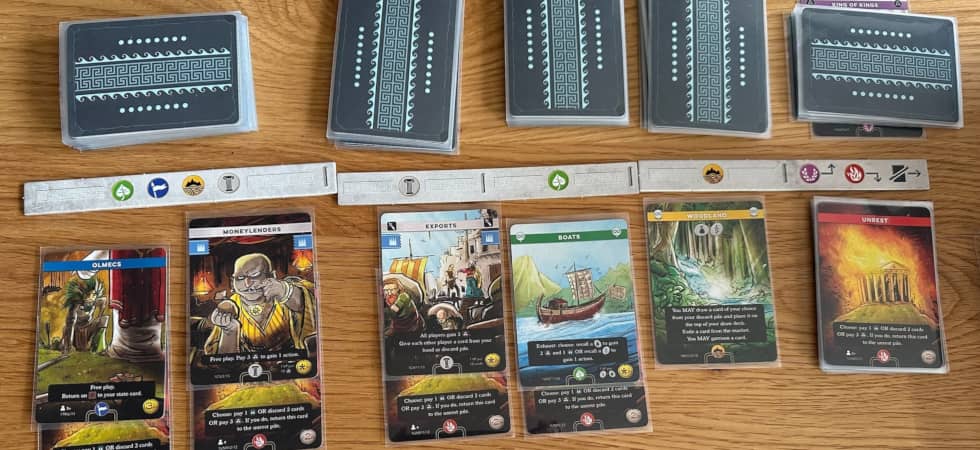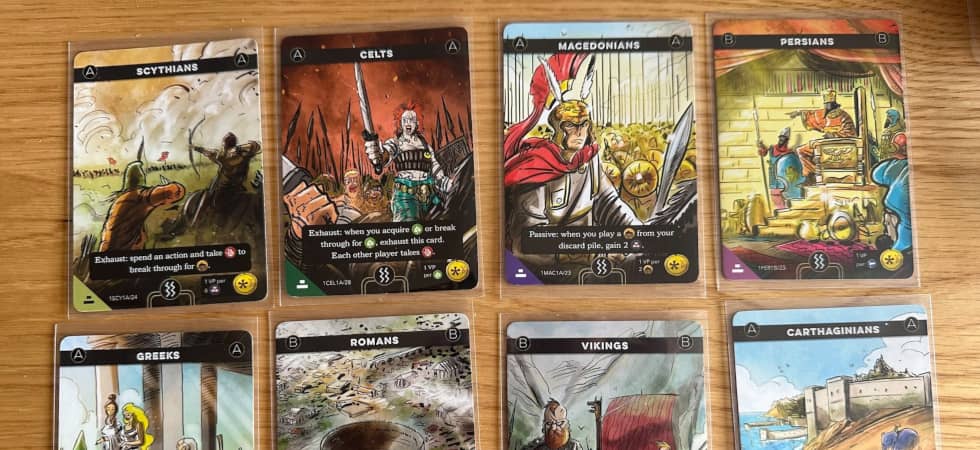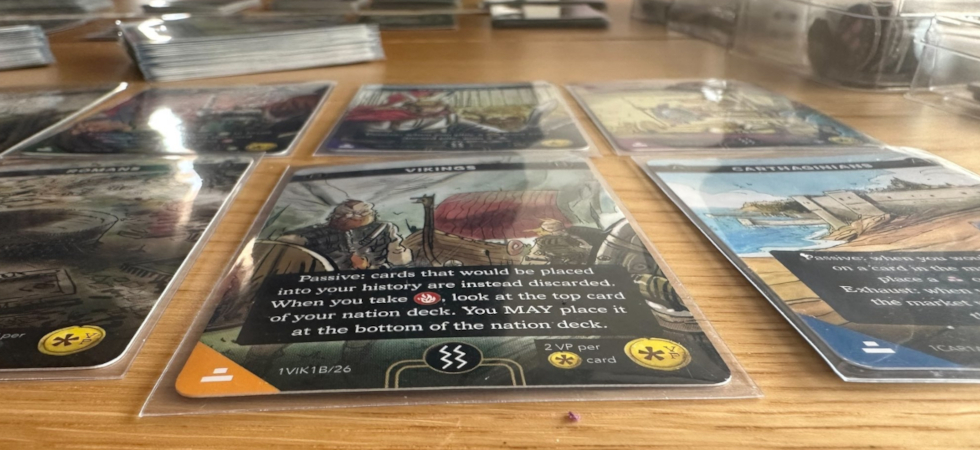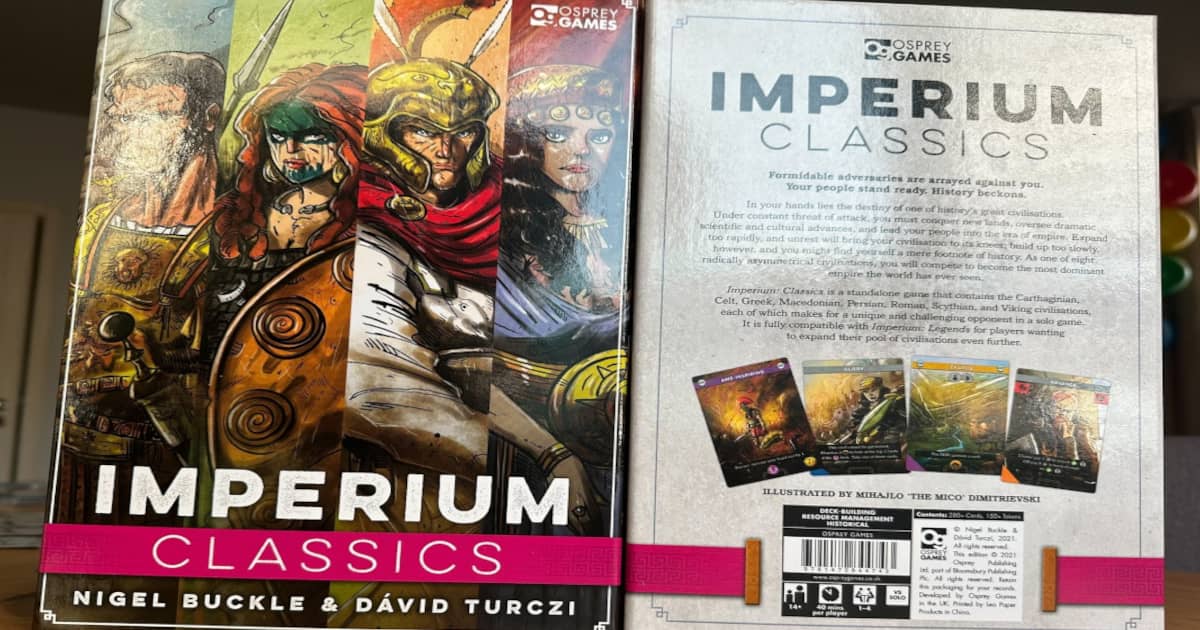What would you need out of a civilization game? Is it the feeling that you are unlocking new achievements and leveraging cultural, technological, and military advantages over your opponents? Or is it just the satisfaction of discovering new ways to play the same civilization, or hone strategies to perfection?
Variety, balance, and a unique approach to the general genre of civilization games is all Imperium Classics offers, and despite a few pointed criticisms, the overall game design is sound, the balance meticulous, and the variety something that I personally appreciate a great deal.
This, I think, is not going to be a review about the inexhaustible variety I have discovered in this game, but a more balanced account of why you may love Imperium Classics, or conversely – pass on it.
What Is Imperium Classics and How Does It Play?
Imperium Classics is a card-driven civilization board game which will have you build your empire by cycling through your deck and by acquiring new cards out of several types, including Tributary, Regions, Civilized and Uncivilized Cards, Unrest Cards, and Fame Cards, all of which add a unique aspect to the gameplay and have you believe that you are indeed developing a civilization – one of eight excellent and fairly unique civilizations that are included in the box.
In terms of city-building, there are Region Cards that you will lay in front of you along with Uncivilized Cards which will introduce settlements, ports, and other buildings associated with commerce, a driver of thriving states and empires. Many of the cards will count towards your victory condition, as they come with points tucked in the bottom right corner.

At the same time, you will want to collect cards that yield a good number of points, but also make sure that you pick the right cards to have your entire civilization engine have a humming start rather than a sputtering misfire.
The cards themselves are interesting for at least two other reasons. Unlike many other deck builders – and make no mistake, Imperium Classics is a deck builder that takes on the ambitious goal of recreating a fully-fledged civilization experience, any new card you acquire will come straight to your hand.
You can use a total of three actions per turn, not accounting for the special Exhaust Tokens which grant extra actions, and any free actions already incorporated in your cards. The other reason why the cards in this deck builder are so interesting is that designers Nigel Buckle and Dávid Turczi have implemented two special symbols into many of the cards.
The Civilized and Uncivilized symbols indicate when you can use a given card. You start out as a Barbarian State but gradually progress to an Empire State – or you may choose not to, or in some cases – your civilization may not even have an Empire State, triggering an end-game condition much earlier. Let’s talk about how any of this happens next.
Imperium Classics: Transitioning from Barbarian to Empire State
As a deck-building game, Imperium Classics will have you running through your starter’s deck of 10 or 12 cards at a rapid pace. You can choose to discard any remaining cards at the end of your turn, which has three actions in general, and some tucked-on bonuses through the Exhaust tokens which are a fun addition. In any event, cycling through your deck will grant you a new development or upgrade that you can take from a neatly-stacked dynasty deck that is unique to each civilization.
While there are some similarities between the cards you can get from the dynasty decks of different civilizations, they are timed to come into play differently, demonstrating how the civilizations – while similar in certain aspects – have their own unique timing when they bring certain aspects of their gameplay online.
And, I can’t stress how much I love this. These are not just the same cards shuffled and rammed into a deck to imitate variety. The cards are distributed across your dynasty and starter’s deck with a very specific purpose from the start, letting civilizations follow their own historic course, have slightly different gameplay and stratagems at their disposal and most certainly – a unique path to victory.
So, after a while of cycling through your deck – you will eventually run of Barbarian State developments to claim. This is when you reach an Empire State, and several things happen. For starters, you supposedly get access to better advancements. I say “supposedly” because what you access later on may not be aligned with your strategy – which is why familiarity with your civilization and the cards available in the common markets is always welcome in a game of Imperium Classics.

But what also happens once you have developed your full Barbarian State deck is that you can no longer use your Barbarian cards – as marked by the unique red symbol on both sides of the cards. Of course, Imperium Classic borrows generously from deck builders to help you mitigate this by burning cards out of the game if you think you don’t need them, and generally establish control over your deck and hand size which is what you would expect from the genre.
And, then again, you can trigger some civilizational advancements that allow you to leverage the power of your barbarian past and ignore the restrictions to bring even more ploys into play. Another very important thing that happens when you transition from Barbarian to Empire States is that you will gain a new set of civilization-specific advancements. These advancements are no longer just drawn from a pile of face-down cards – like is the case with Barbarian State.
You actively choose which advancement to acquire providing you have the resources to purchase it, which gives a further strategic depth of your choices – do you rush through to unlock a particular civilizational advantage, or do you continue to drag out your Barbarian State period in order to secure some other benefit in the early to mid-game instead?
Let’s Face It: Imperium Classics Is Not Perfect – Or So I Am Told
Civilization and 4X (explore, expand, exploit, and exterminate) games being my true calling, I found that there is a cohort of players that were displeased with Imperium Classics. I have been able to read the same concerns that crop up across people’s reviews over and over – and they were not the petulant fit of immature or “spoiled” gamers, but the well-reasoned argument of fellow gamers who loved the genre as much as I do.
So, in this part of the review, I will outline what some of the concerns that kept appearing were, and politely note that I disagree with most of them, starting with components quality. Actually, this is the one bit I agree with.
While the cards and art itself are gorgeous, the abstract “population,” “material,” and “progression” tokens are not very nice to the touch or easy to figure out. Yet, this never bothered me as much and especially after my first playthrough – after which I decided that I would most likely really enjoy the game. In a word, these tokens can be much better, but I won’t dwell on them, other than admit that they look like prototype placeholders more so than the finished product.
Game Length
The game’s length is another interesting topic. I have been able to complete most versus games in less than two hours, assuming that the game stretched on for a reasonably long time with both players trying not to end it early. Remember, there are different end-game triggers in the game. For example:
- You may trigger a civilizational collapse if all the Unrest Cards run out of their dedicated deck
- You may go through the Fame Cards so that you see the last one and trigger an end-game condition
- Players may trigger some unique civilizational ability that brings the game’s end
- You may run through the main deck that combines cards of several types
But just because you can stretch the game – or pivot towards a long-term strategy, does not mean that the game itself is long. Forcing a player to avoid an early collapse is a good strategy to end the game early or gain an advantage. With this being said, I can see why Imperium Classics stretches for a little while longer than it perhaps should.
After dozens of plays, I am fairly certain that the game has a solid balance (although patches are coming up in the latest version of the game, Imperium Horizons and improvements are admittedly necessary for some instances). This is why I would not really be willing to risk reducing the game’s length at the expense of balance, and I don’t really see an issue with the game’s length at its current time frame, this being a civilization game, to begin with.
This almost sums up my criticism of Imperium Classics, which is less of actual criticism and more so an acknowledgement that I understand what people are saying about the game’s drawbacks. It’s also an attempt to communiacte that I think that there is an actual reason behind at least some of the decisions that people complain about.
The Early Day Misprints and Errata
Buying my copy in late 2022 means that I have missed most of the early-day dissatisfaction with misprinted cards and errors in the first copies that rightly had many members of the community (who are no longer with us) say that those were “unacceptable” oversights. Another criticism was pointed at the rulebook. I must admit that I sat down and had a one-hour video playthrough to learn the game, and then I used the book to just settle conflicts and clear up what I had remembered wrongly from the video.

From this standpoint, I can easily say that Imperium Classics has some of the best rulebooks that I have read for the sake of reference – it’s light, it’s quick to sift through and the keywords are easy to spot. I admit that if I had been part of the first-wave gamers, I might have found the experience in some ways equally frustrating, but this is not the case and I maintain that knowing some of the rules and using the rulebook to reference keywords and cards quickly feels excellent in this game.
Never mind Multiplayer, Fear the Automa!
Before we wrap up with some of the visuals and our final judgement and whether this game is indeed for you, I feel that our team needs to mention the automa – which is actually a big part of the game – if you choose it to be. In short, the automa is a strong and worthwhile opponent.
It will feel like you are playing against a player that is bent on defeating you and that poses new challenges that impact you. The automa can also be scaled to be stronger or weaker depending on your personal preferences. While there are some common complaints about figuring out how the automa works at first, I have found no such issues with it.
You simply trace a top-to-bottom table which tells you to trigger a specific effect if a certain card has the keyword or the symbol that is stated in the table. The resulting experience is surprisingly deep and meaningful even though I initially felt that the table with automa action references was a little odd and did not believe that the automa can prove a worthwhile opponent.
I was proven wrong. This being said, I believe the non-player character is excellent and that you can get a lot of great games against it. Then again, I play civilization games against others most of the time, so I am cautiously going to say that imperium Classics does very well insofar as the solo experience is concerned but will not recommend you buy the game solely for this aspect of it.
Highly Thematic Plunge into Civilization Games
I don’t really care much about the art of games or their thematic pull being more heavily focused on replayability and a good core design that allows players to scale and innovate the way they approach games.
But Imperium Classics has gone out of its way to being thematic and beautiful with the civilizations developed in a clever and evocative way that pulls you into a game that is almost too abstract to be deemed a true civilization game, and that nevertheless definitely hits the mark insofar as civilization games are concerned.
I love the theme and I love the mechanics, and while this should not be something a reviewer ever says, I feel this is a testimony to the game’s success at building a thematic civilizational experience, more so than many “best-in-genre” games which I will probably talk about one day.
The beautiful art and design, though, are not a ploy to cover up design flaws or lack of balance – it’s the final touch that pulls a strong game presence together and delivers a gift wrapping with a flourish.
Is Imperium Classics for You?
This is the question I have asked myself this entire review. Am I simply trying to cover for a game that falls short of what it aspires to deliver – a fully-fleshed civilization experience where you will get to try different civilizations and enjoy them a lot?
I think Imperium Classics is all it promises to be. It successfully captures the beauty and strategic depth of a civilization game, but I would even argue that it builds upon that as it introduces many ways to secure victory, press on against your opponent’s temporary weakness or build momentum as you try to get your engine started.
There are no devastating engines to speak of here, and the game feels a little abstract in combat which is reduced to attack cards that affect every player on the table but the attacker. Still, the game offers what I believe is a strong variety, a depth of each playthrough and a true civilization experience despite Imperium Classics’ ambitious premise to do so through deck building as the game’s core mechanic.
The solo mode is also up to par, offering you an increasingly challenging automa that will keep you company until your friends arrive. This being said, I am not sure if I would recommend Imperium Classics if you are a pure solo player at heart.
So, if you are a true fan of civilization games and you have always yearned for a game where you can feel how distinct each faction is, I would say – go for it. Imperium Classics delivers on this and then some.
Score & Game Details
- Components Quality: 7.5/10
- Replayability: 10/10
- Value for Its Money: 10/10
- Designer(s): Nigel Buckle, Dávid Turczi
- Artist(s): Mihajlo Dimitrievski
- Publishers: Osprey Games
- Player Count: 1-4
- Age Range: 14+
- Time Range: 60-120 Min
Imperium Classics FAQs
How long is a game of Imperium Classics?
60-120 minutes. This time is a bit of an underestimate, and the game is more likely to stretch beyond the 120-minute mark for three players.
How many cards are there in Imperium Classics?
281. There are 281 cards in Imperium Classics. The combined card number for Imperium Classics, Legends and Horizons exceeds 1000 cards, including reprints of some of the old cards and fixes to balance.
What civilizations are Imperium Classics?
There are eight civilizations in Imperium Classics. Those include the Scythians, Celts, Macedonians, Persians, Greeks, Romans, Vikings, and Carthaganians.

